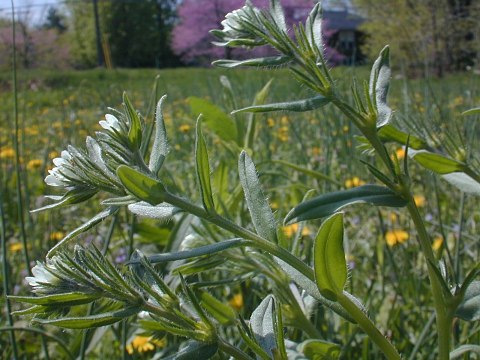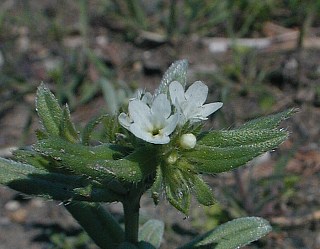Description: This plant is a winter annual or biennial that becomes ½–2' tall, branching very little except at the base. The round stems are more or less hairy. The alternate leaves are up to 1½" long and ¼" across. They are oblanceolate, lanceolate-oblong, or oblong-linear, and sessile at the base. The upper surface of each leaf has a single central vein, but radiating side veins are not visible. The leaves are more or less pubescent, although they occasionally have longer white hairs. Their margins are smooth and ciliate.

The nearly
sessile flowers develop from the axils of the leaves in the upper
portion of the stems. They are bunched together while in bloom or at
the bud stage, but become more separated from each other as the
flowering stems continue to elongate. Each flower is about ¼" long,
consisting of a tubular white corolla with 5 small lobes and a hairy
green calyx with 5 teeth that are linear-lanceolate. These teeth are
about as long as the corolla. There are 5 stamens and a pistil that are
inserted within the narrow throat of the corolla. The blooming period
can occur from mid-spring to mid-summer and lasts about 2 months. Each
flower is replaced by 4 nutlets. A nutlet is truncate at the base and
tapers to a blunt round tip at the top. It is broadest a little below
the middle, and has a greyish brown surface that is rough and wrinkled.
The root system consists of a taproot. This plant spreads by reseeding
itself.
Cultivation:
This adaptable plant can be found in full or partial sun and mesic
conditions in fertile loam, clay-loam, or sandy soil. Open areas are
preferred where there is a scarcity of taller plants.
 Range & Habitat:
Corn Gromwell is occasional to locally common in most areas of
Illinois, except in the NW and SE, where it is uncommon or absent (see Distribution
Map). It is adventive in North America and native to Eurasia.
Habitats include cropland
consisting of winter wheat or rye, fallow fields, vacant lots, grassy
areas along roadsides
and railroads, and miscellaneous waste areas. This weed occurs
primarily in fields or along railroads, but it also appears in run-down
areas of cities. Corn Gromwell prefers disturbed areas, and doesn't
invade high quality natural sites to any significant degree.
Range & Habitat:
Corn Gromwell is occasional to locally common in most areas of
Illinois, except in the NW and SE, where it is uncommon or absent (see Distribution
Map). It is adventive in North America and native to Eurasia.
Habitats include cropland
consisting of winter wheat or rye, fallow fields, vacant lots, grassy
areas along roadsides
and railroads, and miscellaneous waste areas. This weed occurs
primarily in fields or along railroads, but it also appears in run-down
areas of cities. Corn Gromwell prefers disturbed areas, and doesn't
invade high quality natural sites to any significant degree.
Faunal Associations:
Little information is available about floral-faunal relations for this
species. According to Muller of 19th century Germany, the flowers of
Corn Gromwell have few insect visitors. Occasionally, they attracted
White butterflies, bees, and Syrphid flies.
Photographic Location:
A grassy vacant lot in Urbana, Illinois.
Comments:
This is a rather inconspicuous plant even while it is blooming. Corn
Gromwell resembles many other weeds with small white flowers, but it
has a distinguishing characteristic that sets it apart: The teeth of
the hairy calyx are unusually long, slender, and conspicuous – about
the same length as the flowers. Long after the corolla of a flower has
withered away, the teeth of the calyx surround the nutlets on all sides
and are much taller than them. Corn Gromwell resembles other members of
the Borage family to some extent, including the native Lithospermum
latifolium (American Gromwell) and introduced Lithospermum
officinale (European Gromwell). However, these latter species
have wider leaves with conspicuous side veins. Corn Gromwell is easily
distinguished from the many weedy members of the Mustard family because
its tubular flowers have 5 petal-like lobes, while the flowers of the
latter have only 4 petals. An obsolete scientific name for this plant
is Lithospermum
arvense.